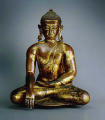
His Eminence Beru Khyentse Rinpoche
© Marpa Activities 1998
Before doing Dream Yoga, it is very important to generate the correct motivation.
Dreams are a continuation of the lifetime of habitual patterns that one
dreams even while
awake. This bardo is referred to as being double-deluded. It is deluded in the
sense that it
arises within the previous bardo, which is deluded, and because itself is deluded.
In the
dream state we also reflect on our collective delusions. When trying to meditate
we
experience all sorts of distraction. The same thing occurs to us while sleeping,
but this is
only a problem if you think they are real.
The Bardo of the Dream State is similar to that when we die except that
its duration is
different. The six senses withdraw into the central alaya - the basis of all
- and one's
senses become dull, etc. Most beings then withdraw into a state of unawareness
but if
you are able to remain conscious you are able to make good use of this time.
One's six
senses still work at this time and objects still appear to them.
One's accumulation of habitual patterns reflects even in the dream state.
For example, in
my waking state I see myself as a lama. Similarly, when I am dreaming, I see
myself as a
lama. Sometimes I dream I am sitting on a throne giving teachings. In this way
it's
possible to use one's time in the dream state to cultivate positive actions
which in turn
affect our waking state.
These experiences don't exist inherently. Enlightened beings' recognition
of this lack of
inherent existence enables them to perform miracles. These aren't at all like
a magician's
deception. Genuine practitioners recognise mundane activity as the mere appearances
of
a dream, whereas ordinary beings take ordinary appearances as existing inherently
and
get attached to them, causing tremendous dissatisfaction.
To benefit from doing dream yoga a practitioner should realise the dream-like
nature of
appearances. They should also have a proper and strong motivation and the determination
to use the dream state in their practice. Normally, if you experience drowning
in a dream,
fear arises. In dream yoga practice, you can change that condition by first
recognising you
are dreaming and then by performing extraordinary activities, like miracles.
Being able to
do this is a sign of success in the practice of dream yoga, but success depends
very
much on your previous accumulation of positive actions. In other words, success
depends
on your mundane activities which in turn get reflected in the dream state.
Gampopa experienced many kinds of dreams which he shared with his Guru,
Milarepa.
Normally, dreams are a mark of delusion, but one dream he shared had much meaning.
The dreams of a particular phase of the dream cycle may be of special significance
in
relation to the waking state. Dreams just prior to waking up sometimes indicate
things
which will make you happy or sad.
The dream and waking states have certain qualities in common. This is why
it is possible
to experience the clear light when practising dream yoga. Gampopa said that
advanced
practitioners don't experience dreams at all when doing dream yoga, as dreams
are an
illusion. Instead they experience the clear light on a constant basis. He proved
this by
cutting off his head in front of his students while saying "This is the
last time I stop
dreaming." Dreams are an illusion, a fault, and as such are something we
need to remove.
Only then will we be able to experience the fundamental clear light, the alaya.
If the
senses completely dissolve from the body during the dream state one can possible
die.
The bardo state between birth and death shouldn't be wasted. This is why
we practise the
yoga of the dream bardo. Both bardos are intimately interconnected. If one can
constantly
practise dharma, even during the dream state, then one establishes strong and
positive
habitual patterns. In this way you make use of your time to the fullest. One's
dream state
very much depends on the habitual patterns brought to it from the waking state.